Barry Dudley is a violin maker in Georgia who specializes in building five-string fiddles.
Traditionally, the violin or fiddle has four strings that are tuned to G, D, A, and E, but a five-string fiddle also includes a lower C string. This combination gives the fiddle a tonal range of both a violin and viola. Although the five-string fiddle is allowing musicians to have a new approach to their playing, historically, bowed instruments with five strings are not a new invention. Jerald Franklin Archer compares five-string violins to similar instruments used in the past in his article 5 String Violins: The Black Sheep of the Family? “The instrument a violinist is familiar with evolved from the viols and some other instruments like the Pardessus de viola, or Quinton, a five-string hybrid instrument, in use during the 18th century, that combines characteristics of the viol and the violin. Its body resembles a violin’s, save for the sloping shoulders; but its neck is fretted like a viol’s. It was tuned g-d’-a’-d”-g”. A fifth string was also included on cellos. “J.S. Bach wrote his last solo ‘cello Partita for an instrument known as the piccolo cello, which was smaller than the normal size of a ‘cello and possessed an added high E string.” The pardessus de viole is the smallest size of viola da gamba, which is the ancestor of the modern double-bass, and it was created around 1690. It started out as an instrument with six strings and then was modified to have five and four strings. The quinton is a variation that has a body similar to a violin.
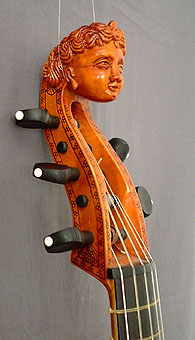
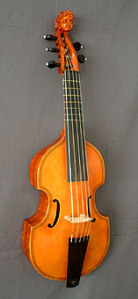
Barry Dudley began building five-string fiddles sometime between 2004 and 2005. He became inspired to build instruments as a guitar player in the early 1970s when he visited Diapason Guitar Shop in Decatur, Georgia, and saw Wade Lowe, a guitar maker and the owner of the shop, carving the headstock of a classical guitar. Wade Lowe became Dudley’s mentor and muse. He did not start building instruments until about twenty years later when he bought a book and taught himself how to build guitars. He took his first guitar over to Wade Lowe, who had been making violins at this point. Lowe told Dudley, “You need to make violins!” Dudley responded, “I can’t play a violin. I don’t know anything about them. I don’t wanna do that.” Wade Lowe was persistent and convinced Barry Dudley to try building violins. After he finished his first violin, he admitted that he was hooked. By 2004-2005, David Blackmon, a fiddle player from Athens, Georgia, visited Dudley’s shop and convinced him to make a five-string violin. He decided to try it and was very satisfied with the results, so he built a few more. He took one of his five-string violins to a venue in Athens, Georgia, where The Duhks were playing. Their violinist, Tania Elizabeth, played his fiddle and ended up buying it from him. Tania Elizabeth was recently seen on the David Letterman Show playing the same violin she bought from Dudley.
Barry Dudley acquires his materials for building fiddles from a few suppliers that he has developed over the years. He buys woods from a supplier in Oregon. His tops come from a company in Missouri that supplies tops for Collings mandolins and guitars. He buys maple in lots of thirty or forty sets at one time directly from Bosnia. Then, he brings it into the shop, measure the moisture content, and puts it up on a shelf to acclimate and age. On average, it takes about 130 to 150 man hours to build one fiddle, and he spends about eight to ten hours a day building. Barry Dudley prefers the sound of Guarneri violins over Stradivari violins, so he has always used Guarneri patterns for building. The first pattern he ever used was Guarneri’s King Joseph. After making a few violins from that pattern, he changed to a pattern from the violin that Niccoló Paganini made famous, The Canon. He bought a set of prints and expanded them about 110%, and that became the pattern he uses for five-string fiddles.
Dudley uses a variety of woods for building violins. He explains that traditionally, violins have always been made out of maple. The backs, sides, and neck are usually maple, and the top is always some type of spruce. Since he began building instruments as a guitar maker, he became curious about using popular guitar woods for building violins. He tried building some with traditional guitar woods such as rosewood, mahogany, black walnut, bubinga, which is an African wood, and ebony. He has also built fiddles from cocobolo, ziricote, imbuia, and shedua. Dudley noticed that many professional or proficient fiddle players became interested in the different types of woods for fiddles. Since these players usually already have good instruments built from maple, many are open to trying a unique fiddle made out of a different type of wood. The main difference between the types of wood he uses is the density, because certain woods are denser and heavier, but he said, “the harmonics and the overtones that are produced from those denser woods are a little more refined, and you get a little more separation between the fundamental, and the secondary, and tertiary harmonics.” Dudley said that he gets the most requests for fiddles made out of bubinga, but it is also the most difficult to work with because the wood is really hard. His favorite wood to work with is ebony because it is more fine and easy to carve. Dudley mentions that he has an idea of how a fiddle is going to sound based on details in the wood while he is building it. During different stages of building he holds up the wood and taps on it to listen to the tone that it produces. He listens for resonance, sustain, and a lively sound. Even early in the building process, these factors determine if the fiddle is going to be outstanding or just good.
Here are pictures of a violin made from East Indian Rosewood:
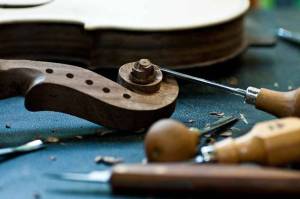
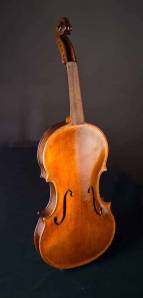
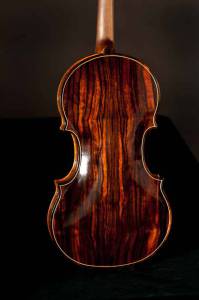

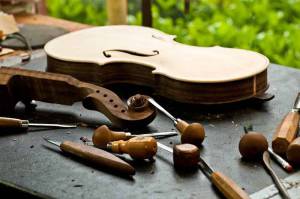
Here are pictures of a violin made from Cocobolo:
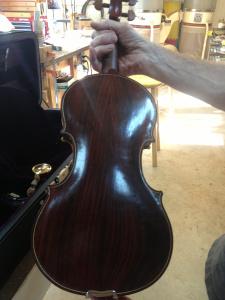
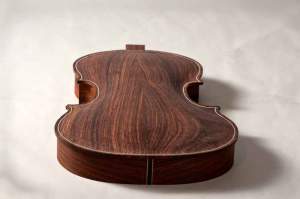
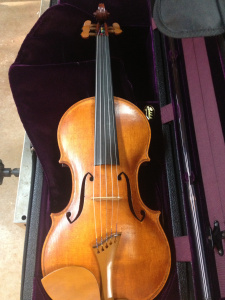
These are pictures of violins made from Bubinga:
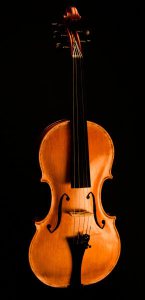
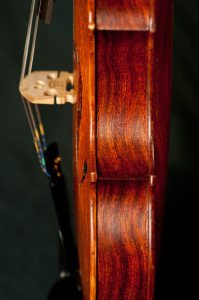
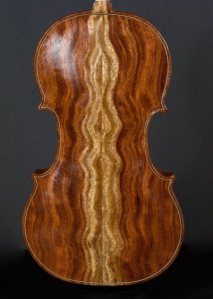
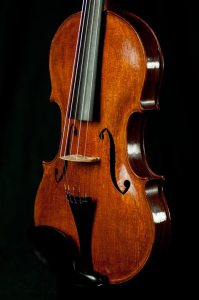
This is a Rosewood fiddle that Barry Dudley made for Bobby Hicks:
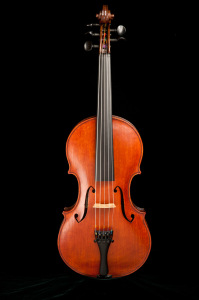
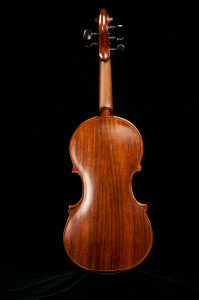
These violins are made from Ebony:
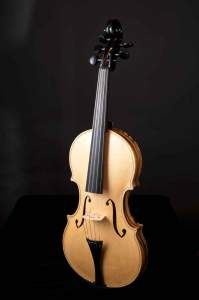
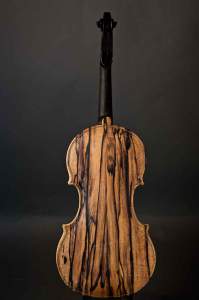
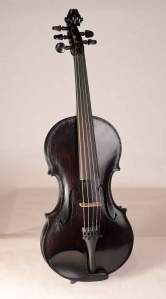

These violins are made from Black Walnut:
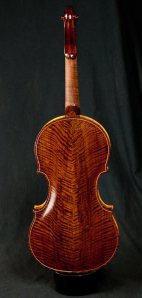
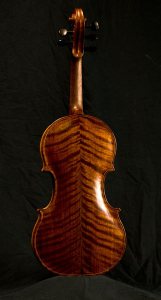
This violin is made from Ziricote:
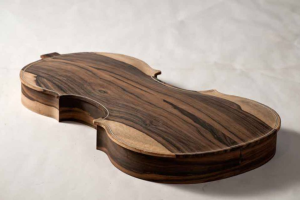
This is the Barry Dudley’s signature design for the f-holes:
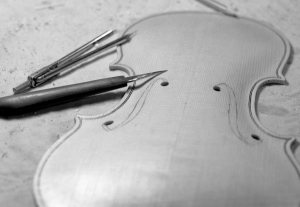
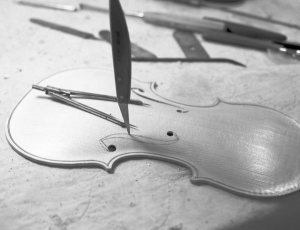
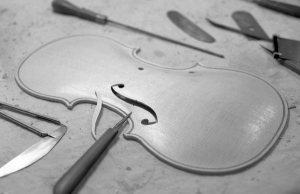
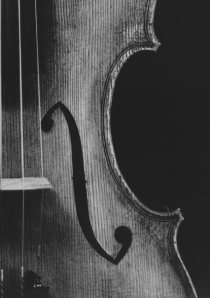
These are some of his patterns for building:


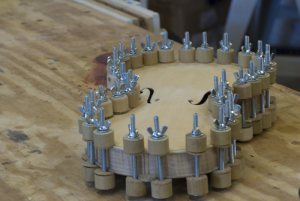
Here are pictures in the shop and one from IBMA with Bobby Hicks playing one of his fiddles:
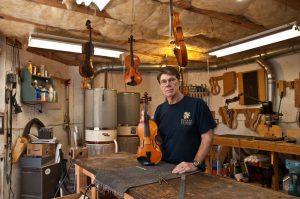

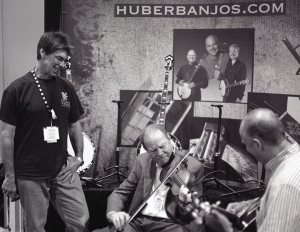
Most of Dudley’s sales come from Europe and Canada, but he has also done business in Australia, Japan, Sweden, Denmark, Finland, Holland, and in the United States. He decides how much to charge for his fiddles by basing the price around what is affordable for working musicians. Dudley explains some of his values, “Believe it or not, I really do — part of the joy of making the instruments is not just the money. I need the money to pay my bills just like everybody else, but it’s the music that people make with the instruments. And so, being able to put the instruments in people’s hands that are — that are actually gonna play them, make music, and make people happy — that’s important to me. You know, that’s a valuable thing to me.”
Barry Dudley states that there is a growing demand for five-string fiddles, and about ninety-five percent of the instruments he builds are five-strings. He states that five-string fiddles have more playing options and the lower C string offers fiddle players a different tonal range that is great for improvising and backing up singers. “I’ve had a lot of fiddle players tell me that they can play licks kind of like a saxophone player, you know — that it allows them to do a lot more things that — that they just never really thought they could do before.” Dudley thinks the five-string fiddle is unlimited in what it can do in contemporary music. He has even had customers that are strongly rooted in classical music use their five-strings to play chamber music.
Barry Dudley believes that there is a growing demand for five-string fiddles, and about ninety-five percent of the instruments he builds are five-strings. Five-string fiddles have more playing options and the lower C string offers fiddle players a different tonal range that works great for improvising and backing up singers. He has even had customers that are strongly rooted in classical music use their five-strings to play chamber music. Dudley thinks the five-string fiddle is unlimited in what it can do in contemporary music.
When asked what style of music most of his customers play, he explains “Most of them play — I hate to say bluegrass — because the term bluegrass is – has changed so much. Contemporary bluegrass and country has melded together. It has a lot of jazz in it, and it has — I think because there’s so many young players now that have come out of classical training — you know, they’ve had school where they’ve been trained as classical players. They bring a lot of that — a lot of that technique and discipline and, the ear for classical music — they bring that to the world of bluegrass or country or Americana, Celtic, all of these genres. Those are the ones that everybody seems to love.”
Dudley compares his fiddles to other popular five-string builders today by stating “I believe that I make quality fiddles and that’s — I think that’s brought out by the fact that I have a good clientele of professional players that could play other people’s instruments, but that’s not to say that my violins are the only good ones out there. Instruments are like our significant others in our lives, you know, you — you find one that you love, and — and you — others that you really like, but they’re not quite that one that you really love, you know, and so — there are other makers that make outstanding instruments that other people may like better than mine. I just hope that I can find more people that like mine the best.”
Barry Dudley currently shows his instruments at two events per year. He travels to IBMA and to Barcelona, Spain. He has been invited to come to Merlefest and is considering traveling there next year.
This video shows two jazz violinists playing on Barry Dudley’s five-string fiddles. Oriol Saña is a jazz professor in Barcelona.
Here is a video of Darol Anger playing a five-string made by Barry Dudley:
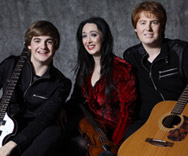

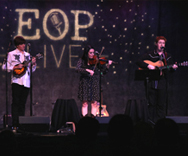
What is the price range of five strings? I play a 16″ four string viola and love the space. Even after some work, my 15″ 5 string is just too smooshed together, in all directions. I want a 16″ five-string with a fingerboard and neck wide enough that my bow arm knows where to go, but that is narrow enough that I can reach four strings comfortably. (I never use all five at once, so going from the C to the E isn’t really a big deal.)
Hi Miranda,
Sorry this is such a late response! I think most of Barry Dudley’s five strings start at around $5,000 and up depending on what type of wood you want for your instrument. Most of his violins are 14 1/2″ and I think they are great for playing doublestops. He makes many different custom designs, so it’s possible that he may make a larger size if you were looking for one. I was used to playing on a standard 14″ four-string violin before I got one of his five strings. I did have to adjust my bow arm for the angle of the strings and the closer spacing between the strings for a few weeks, but I didn’t feel like it was a huge adjustment.
Thanks,
Brittany
I just recently received my Barry Dudley 5 string and I love it! I’m looking for a very strong and secure case to hold my 5 string and 4 string at the same time. Any recommendations?
Thanks!
Hi Matt, we are so sorry to provide such a late response to your inquiry. Thank you for visiting our site! Congratulations on your Dudley 5 string violin! What type of wood did you select for your violin? As far as a double violin case, we do not have much experience. Have you looked into the French case company Bam? They have at least one double case we have seen before. We wish we knew more to tell you. Enjoy your violin!
Thanks!
Raven and Red
info@ravenandred.net
I truly love the design of the fiddles your building and would like to purchase one if they’re not to expensive.
I really like the one with the face on the head and like the striping on the body of the fiddle.
You can get back to me by phone:
501-201-0388 or by the e mail listed.
Hi Daniel, thank you for visiting our site! We appreciate your kind words on behalf of Barry Dudley’s hand-made violins. He certainly is a very talented luthier and the best there is when it comes to 5 string fiddles. May we suggest that you visit his site, and perhaps directly inquire about the style and price of his violins? Here is the link to his website:
http://www.dudleyviolins.com
If you intend to purchase an instrument from Barry, please let us know about it! We love his work, and we would enjoy seeing pictures. Also, please let him know that Raven and Red has referred you.
Thanks!
Raven and Red
info@ravenandred.net
After searching for the best, rich fiddle sound I could find (for 25 years), I stumbled into Dudley’s website. I ordered a 5-string, and when I went to pick it up, I played it, and I could not believe how good the sound was. If you are serious about a good violin sound, whether it is fiddle or classic violin, Dudley violins are very much worth your while, no matter where you have to go to get one. Dudley is only a short distance from the Atlanta International Airport. After I had my Dudley for a while, I got worried about something happening to it so ordered another to use as a backup. Highest recommendation!!